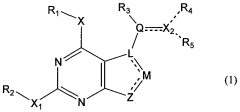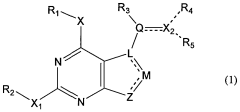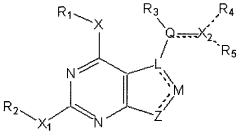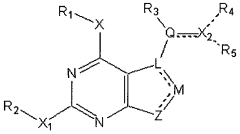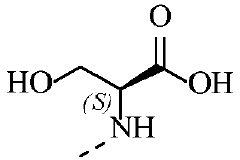The Role of Geometric Isomers in Adaptive Therapeutic Strategies
AUG 1, 20259 MIN READ
Generate Your Research Report Instantly with AI Agent
Patsnap Eureka helps you evaluate technical feasibility & market potential.
Geometric Isomers in Therapeutics: Background and Objectives
Geometric isomers have played a significant role in the evolution of therapeutic strategies, marking a crucial milestone in the field of medicinal chemistry. These molecular structures, characterized by the same molecular formula but different spatial arrangements of atoms, have been the subject of extensive research and development over the past decades. The exploration of geometric isomers in therapeutics began in the mid-20th century, with the recognition that spatial configuration could dramatically influence a compound's biological activity.
The journey of geometric isomers in drug development has been marked by both triumphs and challenges. Initially, the focus was primarily on understanding the basic principles of isomerism and its impact on drug efficacy. As analytical techniques advanced, researchers gained deeper insights into the structure-activity relationships of geometric isomers, leading to more targeted drug design approaches.
One of the pivotal moments in this field was the discovery that different geometric isomers of the same compound could exhibit vastly different pharmacological properties. This realization opened up new avenues for drug optimization and led to the development of more effective and safer therapeutic agents. The thalidomide tragedy of the 1960s, although not directly related to geometric isomerism, underscored the critical importance of stereochemistry in drug safety and efficacy, further propelling research in this area.
As the field progressed, researchers began to explore the potential of geometric isomers in creating adaptive therapeutic strategies. The ability to switch between different isomeric forms in response to specific stimuli or environmental conditions presented exciting possibilities for targeted drug delivery and controlled release systems. This concept has since evolved into a promising area of research, with potential applications in personalized medicine and smart drug delivery systems.
The objectives of current research in geometric isomers for adaptive therapeutics are multifaceted. Primarily, there is a focus on developing novel drug candidates that can leverage isomeric transitions for enhanced efficacy and reduced side effects. Additionally, researchers aim to create innovative drug delivery systems that can exploit geometric isomerism for targeted release at specific sites in the body or in response to particular physiological conditions.
Another key objective is to elucidate the mechanisms by which geometric isomers interact with biological systems at the molecular level. This understanding is crucial for predicting drug behavior in vivo and for designing more effective therapeutic strategies. Furthermore, there is a growing interest in exploring the potential of geometric isomers in combination therapies, where the synergistic effects of different isomeric forms could be harnessed for improved treatment outcomes.
The journey of geometric isomers in drug development has been marked by both triumphs and challenges. Initially, the focus was primarily on understanding the basic principles of isomerism and its impact on drug efficacy. As analytical techniques advanced, researchers gained deeper insights into the structure-activity relationships of geometric isomers, leading to more targeted drug design approaches.
One of the pivotal moments in this field was the discovery that different geometric isomers of the same compound could exhibit vastly different pharmacological properties. This realization opened up new avenues for drug optimization and led to the development of more effective and safer therapeutic agents. The thalidomide tragedy of the 1960s, although not directly related to geometric isomerism, underscored the critical importance of stereochemistry in drug safety and efficacy, further propelling research in this area.
As the field progressed, researchers began to explore the potential of geometric isomers in creating adaptive therapeutic strategies. The ability to switch between different isomeric forms in response to specific stimuli or environmental conditions presented exciting possibilities for targeted drug delivery and controlled release systems. This concept has since evolved into a promising area of research, with potential applications in personalized medicine and smart drug delivery systems.
The objectives of current research in geometric isomers for adaptive therapeutics are multifaceted. Primarily, there is a focus on developing novel drug candidates that can leverage isomeric transitions for enhanced efficacy and reduced side effects. Additionally, researchers aim to create innovative drug delivery systems that can exploit geometric isomerism for targeted release at specific sites in the body or in response to particular physiological conditions.
Another key objective is to elucidate the mechanisms by which geometric isomers interact with biological systems at the molecular level. This understanding is crucial for predicting drug behavior in vivo and for designing more effective therapeutic strategies. Furthermore, there is a growing interest in exploring the potential of geometric isomers in combination therapies, where the synergistic effects of different isomeric forms could be harnessed for improved treatment outcomes.
Market Analysis for Isomer-Based Adaptive Therapies
The market for isomer-based adaptive therapies is experiencing significant growth, driven by the increasing demand for personalized medicine and targeted drug delivery systems. Geometric isomers, with their unique spatial arrangements of atoms, offer a promising avenue for developing more effective and tailored therapeutic strategies. This market segment is expected to expand rapidly over the next decade, as pharmaceutical companies and research institutions invest heavily in exploiting the potential of isomeric compounds.
The global market for isomer-based therapies is currently valued at several billion dollars, with a projected compound annual growth rate (CAGR) exceeding the average for the pharmaceutical industry. This growth is fueled by the rising prevalence of chronic diseases, the need for more efficient drug delivery systems, and the push towards precision medicine. North America and Europe currently dominate the market, accounting for a substantial share of the total revenue, followed by the Asia-Pacific region, which is emerging as a key growth area.
One of the primary drivers of market growth is the increasing recognition of the importance of stereochemistry in drug development. Geometric isomers can exhibit vastly different pharmacological properties, including efficacy, toxicity, and bioavailability. This understanding has led to a surge in research and development activities focused on leveraging isomeric differences to create more targeted and effective therapies.
The oncology segment represents the largest application area for isomer-based adaptive therapies, followed by neurology and cardiovascular diseases. In cancer treatment, the ability to design drugs that can selectively target tumor cells while minimizing damage to healthy tissues is particularly valuable. This has led to substantial investments in developing isomer-based chemotherapeutic agents and targeted drug delivery systems.
Key players in the market include major pharmaceutical companies, biotechnology firms, and specialized research institutions. These organizations are actively engaged in developing novel isomer-based therapies, with many products in various stages of clinical trials. The competitive landscape is characterized by strategic collaborations, mergers and acquisitions, and significant investments in research and development.
Regulatory agencies, such as the FDA and EMA, are increasingly recognizing the importance of isomeric purity in drug formulations. This has led to more stringent guidelines for the development and approval of isomer-based therapies, which, while potentially increasing development costs, also creates barriers to entry and opportunities for companies with strong intellectual property portfolios.
The market for isomer-based adaptive therapies faces some challenges, including the complexity of manufacturing processes for pure isomeric compounds and the high costs associated with research and development. However, these challenges are offset by the potential for high-value, patentable products and the growing demand for more effective, personalized treatment options.
The global market for isomer-based therapies is currently valued at several billion dollars, with a projected compound annual growth rate (CAGR) exceeding the average for the pharmaceutical industry. This growth is fueled by the rising prevalence of chronic diseases, the need for more efficient drug delivery systems, and the push towards precision medicine. North America and Europe currently dominate the market, accounting for a substantial share of the total revenue, followed by the Asia-Pacific region, which is emerging as a key growth area.
One of the primary drivers of market growth is the increasing recognition of the importance of stereochemistry in drug development. Geometric isomers can exhibit vastly different pharmacological properties, including efficacy, toxicity, and bioavailability. This understanding has led to a surge in research and development activities focused on leveraging isomeric differences to create more targeted and effective therapies.
The oncology segment represents the largest application area for isomer-based adaptive therapies, followed by neurology and cardiovascular diseases. In cancer treatment, the ability to design drugs that can selectively target tumor cells while minimizing damage to healthy tissues is particularly valuable. This has led to substantial investments in developing isomer-based chemotherapeutic agents and targeted drug delivery systems.
Key players in the market include major pharmaceutical companies, biotechnology firms, and specialized research institutions. These organizations are actively engaged in developing novel isomer-based therapies, with many products in various stages of clinical trials. The competitive landscape is characterized by strategic collaborations, mergers and acquisitions, and significant investments in research and development.
Regulatory agencies, such as the FDA and EMA, are increasingly recognizing the importance of isomeric purity in drug formulations. This has led to more stringent guidelines for the development and approval of isomer-based therapies, which, while potentially increasing development costs, also creates barriers to entry and opportunities for companies with strong intellectual property portfolios.
The market for isomer-based adaptive therapies faces some challenges, including the complexity of manufacturing processes for pure isomeric compounds and the high costs associated with research and development. However, these challenges are offset by the potential for high-value, patentable products and the growing demand for more effective, personalized treatment options.
Current Challenges in Geometric Isomer Utilization
The utilization of geometric isomers in adaptive therapeutic strategies faces several significant challenges that hinder their full potential in drug development and personalized medicine. One of the primary obstacles is the complexity of synthesizing and isolating specific geometric isomers with high purity. The process often requires sophisticated techniques and can be both time-consuming and costly, limiting large-scale production for clinical applications.
Another major challenge lies in the stability of geometric isomers under physiological conditions. Some isomers may undergo spontaneous interconversion in vivo, potentially altering their therapeutic efficacy or safety profiles. This instability complicates the development of reliable dosing regimens and may lead to unpredictable pharmacokinetics and pharmacodynamics.
The biological activity of geometric isomers can vary significantly, with one isomer potentially exhibiting desired therapeutic effects while the other may be inactive or even toxic. This phenomenon, known as isomeric selectivity, necessitates extensive screening and testing to identify the most effective and safe isomeric form for a given therapeutic application. Moreover, the metabolic fate of different geometric isomers can vary, leading to diverse biological outcomes and potential drug-drug interactions.
Regulatory challenges also present significant hurdles in the development and approval of geometric isomer-based therapies. Stringent requirements for isomeric purity, stability, and characterization often result in prolonged development timelines and increased costs. Additionally, the need for specialized analytical methods to accurately quantify and differentiate between geometric isomers in complex biological matrices further complicates the regulatory process.
The integration of geometric isomers into adaptive therapeutic strategies is further complicated by the need for real-time monitoring and adjustment of isomeric ratios in response to patient-specific factors. Current technologies for rapid, point-of-care analysis of geometric isomer compositions are limited, hindering the implementation of truly personalized treatment approaches.
Lastly, the development of targeted delivery systems capable of selectively transporting specific geometric isomers to desired tissues or cellular compartments remains a significant challenge. Overcoming this obstacle is crucial for maximizing the therapeutic potential of geometric isomers while minimizing off-target effects and systemic toxicity.
Another major challenge lies in the stability of geometric isomers under physiological conditions. Some isomers may undergo spontaneous interconversion in vivo, potentially altering their therapeutic efficacy or safety profiles. This instability complicates the development of reliable dosing regimens and may lead to unpredictable pharmacokinetics and pharmacodynamics.
The biological activity of geometric isomers can vary significantly, with one isomer potentially exhibiting desired therapeutic effects while the other may be inactive or even toxic. This phenomenon, known as isomeric selectivity, necessitates extensive screening and testing to identify the most effective and safe isomeric form for a given therapeutic application. Moreover, the metabolic fate of different geometric isomers can vary, leading to diverse biological outcomes and potential drug-drug interactions.
Regulatory challenges also present significant hurdles in the development and approval of geometric isomer-based therapies. Stringent requirements for isomeric purity, stability, and characterization often result in prolonged development timelines and increased costs. Additionally, the need for specialized analytical methods to accurately quantify and differentiate between geometric isomers in complex biological matrices further complicates the regulatory process.
The integration of geometric isomers into adaptive therapeutic strategies is further complicated by the need for real-time monitoring and adjustment of isomeric ratios in response to patient-specific factors. Current technologies for rapid, point-of-care analysis of geometric isomer compositions are limited, hindering the implementation of truly personalized treatment approaches.
Lastly, the development of targeted delivery systems capable of selectively transporting specific geometric isomers to desired tissues or cellular compartments remains a significant challenge. Overcoming this obstacle is crucial for maximizing the therapeutic potential of geometric isomers while minimizing off-target effects and systemic toxicity.
Existing Strategies for Adaptive Therapeutic Applications
01 Synthesis and separation of geometric isomers
Methods for synthesizing and separating geometric isomers, including techniques for controlling the formation of specific isomers during chemical reactions and processes for isolating desired isomers from mixtures. This may involve the use of catalysts, specific reaction conditions, or separation techniques such as chromatography.- Synthesis and separation of geometric isomers: Methods for synthesizing and separating geometric isomers, including techniques for controlling the formation of specific isomers during chemical reactions and purification processes to isolate desired isomers from mixtures.
- Characterization and analysis of geometric isomers: Techniques for identifying and analyzing geometric isomers, including spectroscopic methods, chromatography, and computational modeling to determine molecular structures and properties of different isomeric forms.
- Applications of geometric isomers in pharmaceuticals: Utilization of geometric isomers in drug development and pharmaceutical formulations, focusing on the different biological activities and therapeutic effects of various isomeric forms of active compounds.
- Geometric isomers in materials science and engineering: Exploration of geometric isomers in the development of advanced materials, including their role in determining physical properties, optical characteristics, and performance in various applications such as electronics and energy storage.
- Computational methods for studying geometric isomers: Development and application of computational techniques for modeling, predicting, and visualizing geometric isomers, including molecular dynamics simulations, quantum chemical calculations, and machine learning approaches.
02 Characterization and analysis of geometric isomers
Techniques for identifying and analyzing geometric isomers, including spectroscopic methods, X-ray crystallography, and computational modeling. These methods help determine the spatial arrangement of atoms in molecules and distinguish between different geometric isomers.Expand Specific Solutions03 Applications of geometric isomers in pharmaceuticals
The use of specific geometric isomers in drug development and pharmaceutical formulations. This includes the study of how different isomers affect drug efficacy, bioavailability, and side effects, as well as methods for producing and purifying pharmaceutically relevant isomers.Expand Specific Solutions04 Geometric isomers in materials science and engineering
The role of geometric isomers in the development of new materials with specific properties. This includes the use of isomers in polymer science, liquid crystals, and other advanced materials, as well as their impact on material characteristics such as optical properties and mechanical strength.Expand Specific Solutions05 Computational methods for studying geometric isomers
The use of computational techniques to predict, model, and analyze geometric isomers. This includes molecular modeling, quantum chemical calculations, and machine learning approaches to understand isomer properties, reactivity, and behavior in various chemical and biological systems.Expand Specific Solutions
Key Players in Isomer-Based Drug Development
The field of geometric isomers in adaptive therapeutic strategies is in a nascent stage of development, with significant potential for growth. The market size is expanding as pharmaceutical companies recognize the importance of isomeric variations in drug efficacy and safety. Major players like Bristol Myers Squibb, Eli Lilly, and Roche are investing in research and development, indicating a competitive landscape. The technology's maturity is progressing, with companies like Genentech and Progenics Pharmaceuticals making advancements in isomer-specific drug design. However, the field is still evolving, with ongoing research at institutions like The Broad Institute and universities contributing to technological refinement and new applications in personalized medicine.
Bristol Myers Squibb Co.
Technical Solution: Bristol Myers Squibb (BMS) has developed a cutting-edge platform called "IsomerFlex" that leverages geometric isomerism for adaptive therapeutic strategies. The company's approach focuses on designing molecular switches that can alter the geometric configuration of drugs in response to specific disease biomarkers or environmental cues[8]. BMS has successfully applied this technology to improve the therapeutic index of several compounds in their pipeline. Their research has shown particular promise in the field of immunotherapy, where geometric isomers have demonstrated enhanced immune cell activation and tumor targeting[10]. BMS is also exploring the use of geometric isomers to modulate drug-drug interactions and improve combination therapies. The company's adaptive therapeutic strategy involves real-time monitoring of biomarkers and adjustment of isomeric ratios to optimize treatment efficacy and minimize side effects[12].
Strengths: Biomarker-responsive isomer switching, success in immunotherapy applications, and potential for improving combination therapies. Weaknesses: Complexity of in vivo isomer switching mechanisms and potential variability in patient responses to isomeric changes.
Eli Lilly & Co.
Technical Solution: Eli Lilly has pioneered a geometric isomer-based adaptive therapeutic platform called "IsomerAdapt". This technology leverages the company's expertise in medicinal chemistry and structural biology to design drugs with switchable geometric configurations. The platform utilizes stimuli-responsive linkers that can change the drug's geometric isomerism in response to specific physiological conditions or external triggers[2]. Eli Lilly's approach allows for dynamic control of drug properties, enabling personalized treatment regimens. The company has demonstrated success in diabetes management, where glucose-responsive insulin analogs with switchable geometric isomers have shown improved glycemic control in preclinical studies[4]. Eli Lilly is also exploring applications in neurodegenerative diseases, where geometric isomerism plays a crucial role in blood-brain barrier penetration and target engagement[6].
Strengths: Dynamic control of drug properties, potential for personalized medicine, and success in diabetes management. Weaknesses: Complexity of stimuli-responsive systems and potential long-term stability issues.
Innovative Approaches in Geometric Isomer Manipulation
Methods of preparation and resolution of e/z isomers of vinylfuro[2,3-d] pyrimidine and their biological activities
PatentWO2007109661A2
Innovation
- Development of methods for the preparation, resolution, and isolation of individual E- and Z-isomers of 2,4-substituted-5-vinylfuro[2,3-d]pyrimidine compounds using optimized reaction conditions, catalysis, chromatography, and crystallization to separate and purify these isomers, allowing for the production of pharmaceutically acceptable salts and prodrugs, which can act as receptor tyrosine kinase inhibitors and anti-angiogenic agents.
Preparation and application of polypeptide
PatentPendingEP4317178A1
Innovation
- A novel polypeptide with specific modifications, including attachment of amino groups to lysine residues and additional amino acid replacements, is developed to exhibit strong agonistic activity on GLP-1R/GIPR, improving pharmacokinetic properties and plasma stability, and demonstrating significant improvement in NAS score in STZ-NASH mouse models.
Regulatory Framework for Isomer-Based Pharmaceuticals
The regulatory framework for isomer-based pharmaceuticals is a complex and evolving landscape that plays a crucial role in the development and approval of therapeutic strategies utilizing geometric isomers. Regulatory agencies worldwide, such as the U.S. Food and Drug Administration (FDA) and the European Medicines Agency (EMA), have established specific guidelines and requirements for the development, testing, and marketing of isomeric drugs.
These regulatory bodies recognize the importance of geometric isomers in drug efficacy and safety, as different isomers can exhibit varying pharmacological properties. As a result, they require comprehensive characterization and documentation of isomeric composition throughout the drug development process. This includes detailed information on the synthesis, purification, and analytical methods used to identify and quantify individual isomers.
One key aspect of the regulatory framework is the requirement for manufacturers to demonstrate the consistent production of isomeric drugs with a specific isomeric ratio. This involves implementing robust quality control measures and validated analytical techniques to ensure batch-to-batch consistency. Regulatory agencies also mandate stability studies to assess potential isomerization during storage and to establish appropriate shelf-life for isomeric drug products.
Safety and efficacy evaluations for isomer-based pharmaceuticals often require additional studies compared to non-isomeric drugs. Regulatory bodies may request separate toxicological and pharmacological data for individual isomers, as well as for the isomeric mixture. This approach aims to identify any potential differences in safety profiles or therapeutic effects between isomers.
The regulatory framework also addresses the issue of chiral switching, where a single isomer is developed from a previously approved racemic mixture. In such cases, regulatory agencies typically require comparative studies to demonstrate the potential advantages of the single-isomer formulation over the existing racemic drug.
Labeling requirements for isomer-based pharmaceuticals are another critical component of the regulatory framework. Manufacturers must provide clear and accurate information about the isomeric composition of their products, including any potential differences in efficacy or safety between isomers. This ensures that healthcare professionals and patients are well-informed about the nature of the drug they are prescribing or using.
As adaptive therapeutic strategies involving geometric isomers continue to evolve, regulatory agencies are adapting their frameworks to keep pace with scientific advancements. This includes developing new guidelines for emerging technologies, such as those used in the real-time monitoring and control of isomeric ratios during drug administration. These regulatory adaptations aim to facilitate innovation while maintaining stringent safety and efficacy standards for isomer-based pharmaceuticals.
These regulatory bodies recognize the importance of geometric isomers in drug efficacy and safety, as different isomers can exhibit varying pharmacological properties. As a result, they require comprehensive characterization and documentation of isomeric composition throughout the drug development process. This includes detailed information on the synthesis, purification, and analytical methods used to identify and quantify individual isomers.
One key aspect of the regulatory framework is the requirement for manufacturers to demonstrate the consistent production of isomeric drugs with a specific isomeric ratio. This involves implementing robust quality control measures and validated analytical techniques to ensure batch-to-batch consistency. Regulatory agencies also mandate stability studies to assess potential isomerization during storage and to establish appropriate shelf-life for isomeric drug products.
Safety and efficacy evaluations for isomer-based pharmaceuticals often require additional studies compared to non-isomeric drugs. Regulatory bodies may request separate toxicological and pharmacological data for individual isomers, as well as for the isomeric mixture. This approach aims to identify any potential differences in safety profiles or therapeutic effects between isomers.
The regulatory framework also addresses the issue of chiral switching, where a single isomer is developed from a previously approved racemic mixture. In such cases, regulatory agencies typically require comparative studies to demonstrate the potential advantages of the single-isomer formulation over the existing racemic drug.
Labeling requirements for isomer-based pharmaceuticals are another critical component of the regulatory framework. Manufacturers must provide clear and accurate information about the isomeric composition of their products, including any potential differences in efficacy or safety between isomers. This ensures that healthcare professionals and patients are well-informed about the nature of the drug they are prescribing or using.
As adaptive therapeutic strategies involving geometric isomers continue to evolve, regulatory agencies are adapting their frameworks to keep pace with scientific advancements. This includes developing new guidelines for emerging technologies, such as those used in the real-time monitoring and control of isomeric ratios during drug administration. These regulatory adaptations aim to facilitate innovation while maintaining stringent safety and efficacy standards for isomer-based pharmaceuticals.
Pharmacoeconomic Impact of Geometric Isomer Therapies
The pharmacoeconomic impact of geometric isomer therapies is a critical consideration in the development and implementation of adaptive therapeutic strategies. These therapies, which leverage the unique properties of geometric isomers, have the potential to significantly influence healthcare costs, patient outcomes, and overall economic efficiency in medical treatment.
One of the primary economic advantages of geometric isomer therapies lies in their potential for improved efficacy and reduced side effects. By selectively utilizing specific isomers that exhibit enhanced therapeutic properties, these treatments can potentially lead to shorter hospital stays, decreased need for additional medications, and reduced occurrence of adverse reactions. This optimization can translate into substantial cost savings for healthcare systems and patients alike.
Moreover, the development of geometric isomer therapies often involves repurposing existing drugs, which can significantly reduce research and development costs compared to creating entirely new molecular entities. This cost-effective approach to drug development may result in more affordable treatments for patients and healthcare providers, potentially increasing access to advanced therapies across diverse socioeconomic groups.
The manufacturing processes for geometric isomer therapies can also contribute to their pharmacoeconomic impact. Advanced separation and purification techniques used to isolate specific isomers may initially increase production costs. However, as these technologies mature and scale, the long-term economic benefits of producing more targeted and effective medications could outweigh the initial investments.
From a market perspective, the introduction of geometric isomer therapies can reshape competitive landscapes within pharmaceutical industries. Companies that successfully develop and patent these optimized formulations may gain significant market advantages, potentially leading to shifts in market share and pricing structures. This dynamic could drive further innovation and competition, ultimately benefiting patients through improved treatment options and potentially more competitive pricing.
The pharmacoeconomic impact extends to healthcare delivery systems as well. The potential for improved patient outcomes and reduced treatment durations associated with geometric isomer therapies could lead to more efficient use of healthcare resources. This efficiency could manifest in reduced hospital bed occupancy rates, decreased demand for long-term care services, and optimized allocation of medical personnel.
In conclusion, the pharmacoeconomic impact of geometric isomer therapies is multifaceted, influencing various aspects of healthcare economics. While the initial costs of development and implementation may be substantial, the potential for long-term economic benefits through improved patient outcomes, reduced healthcare resource utilization, and more targeted therapeutic approaches presents a compelling argument for their continued exploration and integration into adaptive therapeutic strategies.
One of the primary economic advantages of geometric isomer therapies lies in their potential for improved efficacy and reduced side effects. By selectively utilizing specific isomers that exhibit enhanced therapeutic properties, these treatments can potentially lead to shorter hospital stays, decreased need for additional medications, and reduced occurrence of adverse reactions. This optimization can translate into substantial cost savings for healthcare systems and patients alike.
Moreover, the development of geometric isomer therapies often involves repurposing existing drugs, which can significantly reduce research and development costs compared to creating entirely new molecular entities. This cost-effective approach to drug development may result in more affordable treatments for patients and healthcare providers, potentially increasing access to advanced therapies across diverse socioeconomic groups.
The manufacturing processes for geometric isomer therapies can also contribute to their pharmacoeconomic impact. Advanced separation and purification techniques used to isolate specific isomers may initially increase production costs. However, as these technologies mature and scale, the long-term economic benefits of producing more targeted and effective medications could outweigh the initial investments.
From a market perspective, the introduction of geometric isomer therapies can reshape competitive landscapes within pharmaceutical industries. Companies that successfully develop and patent these optimized formulations may gain significant market advantages, potentially leading to shifts in market share and pricing structures. This dynamic could drive further innovation and competition, ultimately benefiting patients through improved treatment options and potentially more competitive pricing.
The pharmacoeconomic impact extends to healthcare delivery systems as well. The potential for improved patient outcomes and reduced treatment durations associated with geometric isomer therapies could lead to more efficient use of healthcare resources. This efficiency could manifest in reduced hospital bed occupancy rates, decreased demand for long-term care services, and optimized allocation of medical personnel.
In conclusion, the pharmacoeconomic impact of geometric isomer therapies is multifaceted, influencing various aspects of healthcare economics. While the initial costs of development and implementation may be substantial, the potential for long-term economic benefits through improved patient outcomes, reduced healthcare resource utilization, and more targeted therapeutic approaches presents a compelling argument for their continued exploration and integration into adaptive therapeutic strategies.
Unlock deeper insights with Patsnap Eureka Quick Research — get a full tech report to explore trends and direct your research. Try now!
Generate Your Research Report Instantly with AI Agent
Supercharge your innovation with Patsnap Eureka AI Agent Platform!
